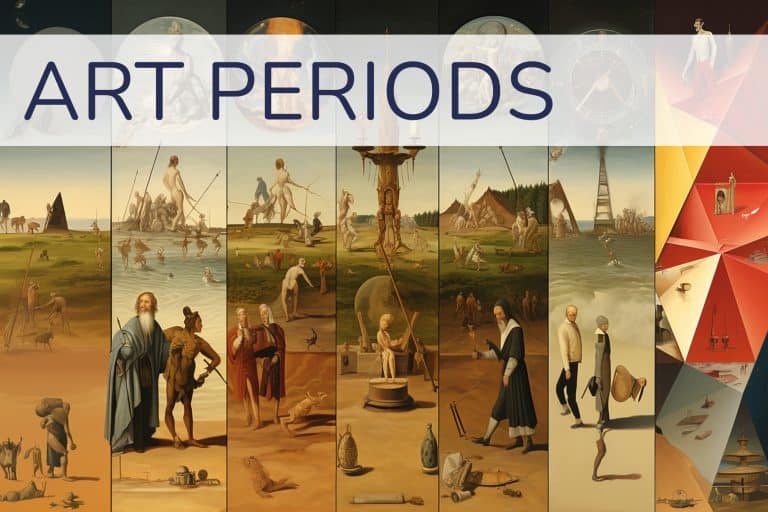Paleolithic Art – A Look at Paleolithic Culture and Its History
Upper Paleolithic artwork is the oldest type of prehistoric art. Paleolithic cave paintings composed of hand stencils and basic geometric forms are dated slightly earlier, dating back at least 40,000 years. The appearance of figurative paleolithic drawings has been seen as symbolizing the onset of social modernization in Paleolithic culture, and it is one of the distinguishing features that divide the Upper Paleolithic period from the Middle Paleolithic period. The uncovering of paleolithic paintings in caves in Indonesia that are equivalent in age to the earliest European specimens has proved that comparable creative practices existed 40,000 years ago in both western and eastern Eurasia.
Paleolithic Artwork Definition and History
What does Paleolithic mean and what is the Paleolithic art definition? Before we get into the history of cave paintings, it might help to first understand these terms. The Paleolithic Age, which lasted from around 30,000 BCE to 10,000 BCE, provided the earliest achievements in human inventiveness.
Because of the scarcity of written documents from this period of time, almost all of our understanding about Paleolithic culture and ways of life comes through archeological and anthropological analogies to current hunter-gatherer tribes.
The Paleolithic period continued until the ice retreated when agriculture and the use of metallurgy were introduced. It has been proposed that the first coastal migrant movement propagated an artistic heritage reaching back more than 50,000 years all along Eurasia’s southern coast.
Paleolithic Culture
A hunter-gatherer economy was common in Paleolithic cultures. People hunted wild creatures for sustenance and collected nourishment, wood, and resources for weapons, clothing, and refuge. The development of these systems regarding food and shelter cannot be pinpointed, but they were critical to humanity’s advancement. Dwellings got more sophisticated, intricate, and home-like as the Paleolithic age advanced.
At the conclusion of the Paleolithic epoch, people began to create artworks such as Paleolithic cave paintings and jewelry, as well as religious traditions like ritualistic burial practices.
Early humans sought areas that could be protected from predators and competition, as well as from severe weather. Many of these areas might be found near lakes, and streams, possibly with neighboring low hilltops that could serve as shelters. Many of these sites have been damaged as a result of water’s ability to erode and modify terrain dramatically. As a result, our comprehension of Paleolithic homes is restricted.

Humans began building temporary wood homes as early as 380,000 BCE. Other sorts of dwellings occurred; they were mostly sites in caves or the open air with no formal construction. Shelters within caves are the oldest examples, followed by dwellings made of straw, wood, and rock.
Caves are the most well-known instance of Paleolithic dwellings, yet the quantity of caverns used by Paleolithic humans is insignificant in relation to the total of hominids assumed to have inhabited Earth at the time. Most hominids certainly never explored, let alone resided in, a cave.
Nevertheless, the traces of hominid dwellings reveal intriguing patterns. A community of Neanderthals maintained a hearth fire blazing for a thousand years in one cavern, leaving a pile of embers and ashes behind. Postholes on the dirt floor suggest that the dwellers erected some form of shelter or enclosures with a roof to shield themselves from water dropping on them from the cavern roof in another cave. Many examples of Paleolithic paintings can be found in the caves despite not being major sources of habitat.
History of Cave Paintings
Altamira in Spain was the first cave decorated with paint that has been recognized as Paleolithic. Experts determined that the art uncovered there was the product of contemporary humans (Homo sapiens). The majority of Paleolithic cave paintings have been discovered in France and Spain, although a few examples have also been discovered in England, Portugal, Italy, Germany, Romania, Russia, and Indonesia.
There are around 400 known adorned sites. The majority of cave Paleolithic drawings and paintings are in either black or red pigment. The reds were created using hematite, while the blacks were created using charcoal. Sculptures have also been uncovered, including ceramic figurines of bison in 1912 in the Tuc d’Audoubert cave and a bear sculpture in 1923 in the Montespan cave. Engraved murals were uncovered in 1909 in Cap Blanc, and the Vienne shelters at Roc-aux-Sorciers in 1950.
In several different caves and dwellings, engravings were carved with fingertips on flexible surfaces or with stone tools on solid walls. Humans are rarely shown in caves, whether colored or otherwise, however, human faces or sexual organs do emerge on occasion.
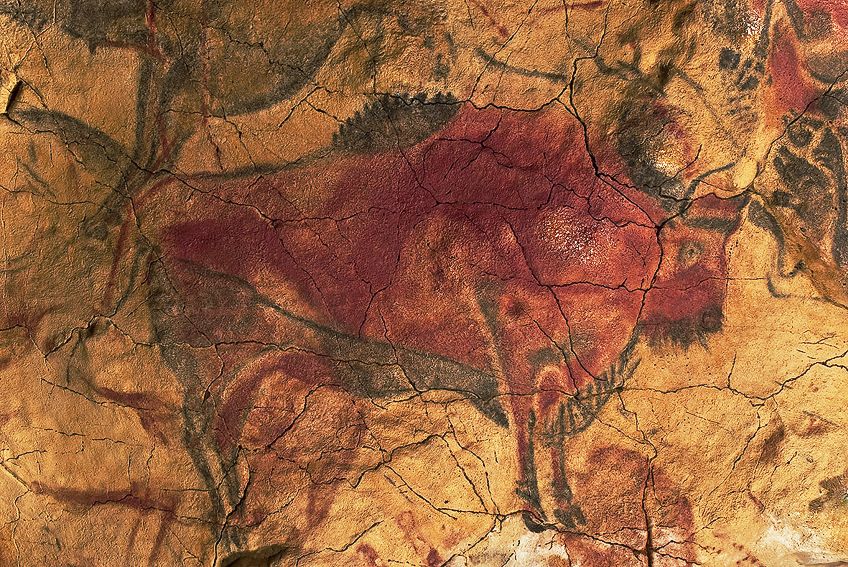
Hand stencils and palm prints are typical of older eras. Animal figures have always made up the preponderance of representations in caves from all epochs. Mammoths, cave lions, rhinoceroses, and bears were the most often featured animals during the early millennia when Paleolithic cave paintings were initially being formed. Bison, Horses, aurochs, and ibex were common later, as shown in the Niaux and the Lascaux caves. Fish and birds were not frequently shown.
Geometric indications are always numerous, albeit the precise types vary depending on the particular era and location of the cave. Paleolithic paintings are often thought to have a representational or religious purpose or both. The paintings’ specific significance is unknown, although some scholars believe they were constructed within the context of shamanic concepts and activities.
One such ritual was entering a deep cave for a ritual during which a healer would achieve a hypnotic state and transmit his or her consciousness into the alternate dimension to establish contact with deities and seek their compassion.
Paleolithic Artwork Across the World
Comparable cultural practices existed 40,000 years ago in both east and west Eurasia, as evidenced by the discovery of cave paintings in Indonesia that is equivalent in age to the oldest European counterparts.
This has been understood to mean that during the first coastal migratory migration, a more than 50,000-year-old artistic heritage spread throughout Eurasia’s southern coastline.
In 2018, a figurative artwork of an unknown species was uncovered in a cave on the Indonesian island of Borneo. It was over 40,000 years old. Let us take a look at the development of Paleolithic drawings and paintings throughout the various regions of the world.
Europe
Rock and cave painting, sketching, jewelry, carving, engraving, and sculpting are examples of Upper Paleolithic European art. There were also musical instruments like flutes, as well as sculptures made of clay, antler segments, bones, stones, and ivory, such as the Venus figurines. Functional items including spear throwers, perforated batons, and lights were also embellished.
Engravings on flat slabs of stone can be found in large numbers at locations with the right geology, with the markings often so shallow and faint that the method used is more akin to sketching – many of them were missed by the first excavators and discovered in spoil heaps by later crews.

Painted plaques are rarer. It’s conceivable they were employed in rituals, or that they were cooked on a fire and bundled as personal warmers. Either form of use might account for the numerous broken instances, which are frequently distributed over a long area. Many sites appear to have huge amounts of flat stones used as flooring, with just a fraction ornamented.
The human form was shown fairly seldom in comparison to animal portrayal; most prominent are the Venus figurines (depiction of the feminine figure, accentuating bosom and buttocks).
The Hohenstein-Stadel Lion-man is a composite monster with a lion’s face on a human frame. Other probable hybrid images include the Shaman of Trois-Frères and a “Bison-man” from the very same cave complex, another “Bison-man” from the Grotte de Gabillou, and what seems to be a bird-headed figure in the Lascaux caves.
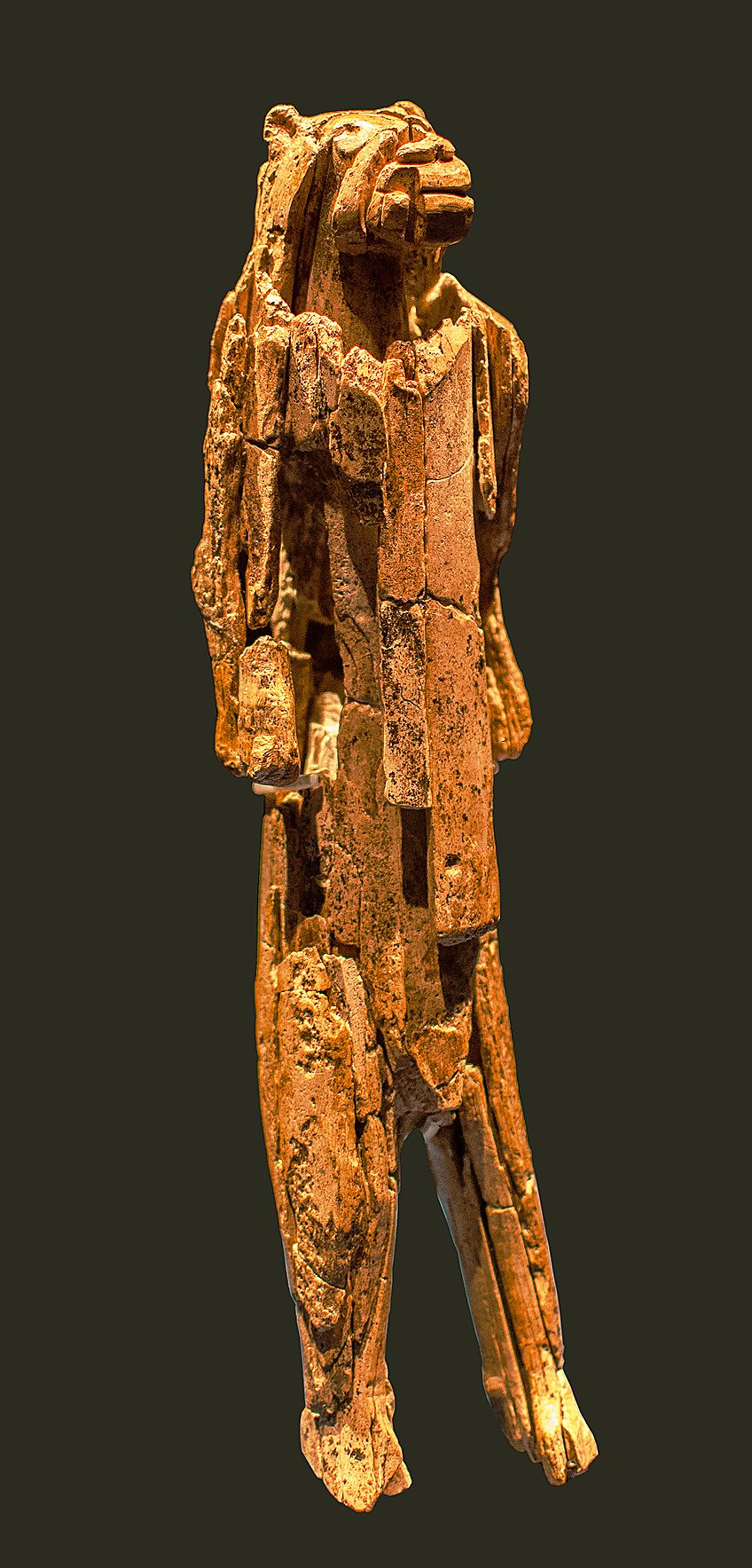
Male representation is uncommon prior to the beginning of the Mesolithic. There is an indication for some artisan expertise, as well as the conveyance of resources such as stone and, most notably, seashells, which were widely used for jewelry and, most likely, clothing decoration.
Shells from Mediterranean varieties have been discovered at Gönnersdorf, which is nearly 1,000 kilometers from the Mediterranean shore. Because of rising sea levels, the location and character of Upper Paleolithic coastal villages are now underwater and undetermined.
East and Southeast Asia
A 2014 study used Uranium–thorium analysis to date cave art from the Indonesian island of Sulawesi’s Caves. The oldest paleolithic drawing to be dated was a hand stencil, which had a baseline age of 39,900 years.
The artwork of a babirusa has been traced to at least 33,400 BCE, making it one of the world’s oldest figurative portrayals.

A cave filled with human remains in Turobong, South Korea, has been revealed to include carved deer bone fragments and images of deer that might be 40,000 years old. Petroglyphs depicting deer or reindeer discovered at Sokchang-ri might potentially be Upper Paleolithic. Potsherds in the manner of early Japanese craftsmanship have been discovered in Kosan-ri on Jeju island, which would have been approachable from Japan at the period due to lower sea levels.
In November 2018, experts revealed the discovery of the earliest known figurative artwork of an unidentified animal, approximately 40,000 in Borneos’ Lubang Jeriji Saléh caves.
Australia
Gabarnmung is an Indigenous excavation and rock art location in Northern Territory’s Arnhem Land. Paleolithic paintings of fish, as well as wallabies, crocodiles, humans, and spiritual beings, may be found in the rock shelter. The majority of the artworks are on the shelter’s ceilings, although several are also on the site’s sides and columns.
Radiocarbon analysis of charcoal retrieved from the ground’s lowest stratigraphic stratum yielded an age indicating the initial era for human occupation before 27,000 years ago.
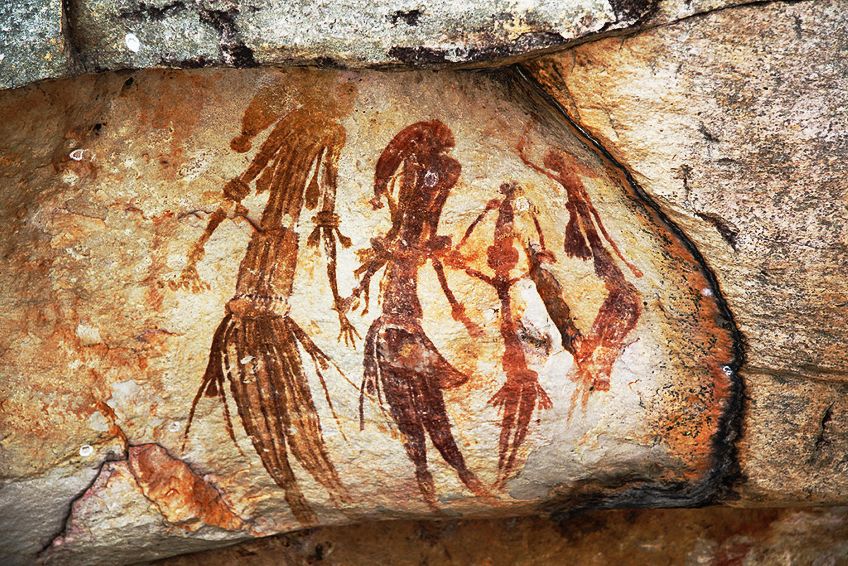
Hematite pigments have been discovered at surrounding localities in layers ranging from 45,000 to 60,000 years old, implying that the Gabarnmung shelter was adorned from the beginning. The rock art of Gwion Gwion is a unique style of Western Australian rock art. They are mostly human figures painted in exquisite detail with precise anatomical proportions.
They have been determined to be more than 17,000 years old.
Africa
Paleolithic locations in the Near East, including the Hayonim Cave in Israel, feature wall carvings portraying symbolic patterns and creatures, such as a galloping horse assigned to the Levantine Aurignacian approximately 28000 BP and viewable in the Israel Museum.
This is said to be the first art object discovered in the setting of the Levantine Paleolithic period.
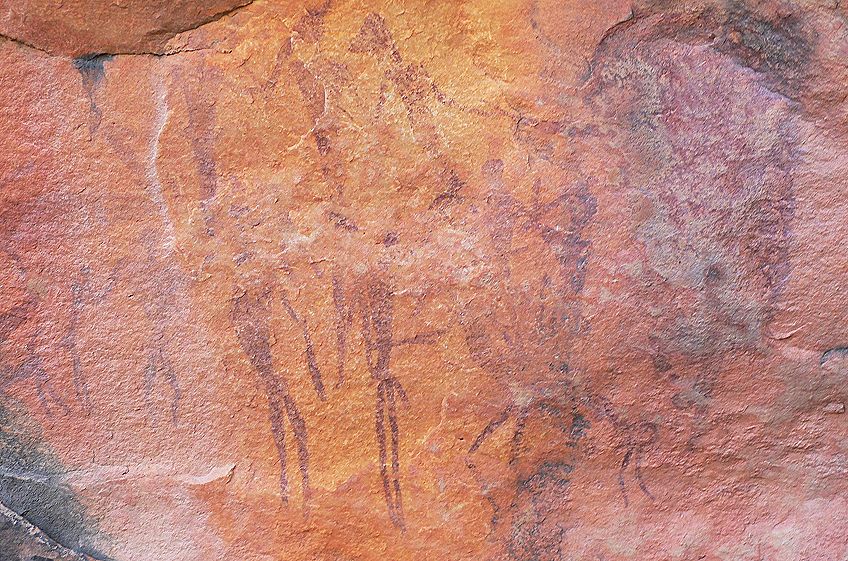
North African Mesolithic petroglyphs, such as those at Tassili n’Ajjer in Algeria, are estimated to be 12,000 to 10,000 years old. The oldest representational artwork from Sub-Saharan Africa is a set of seven rock plaquettes decorated with figurines discovered at the Apollo 11 Cave site in Namibia between 27,500 and 22,500 years ago.
Throughout Southern Africa, there is a significant quantity of rock art attributed to the San people. Much of this art is contemporary as seen by pictures of carts and European colonists wearing caps, but the earliest fragments have been provisionally dated to as far as 26,000 years ago.
Americas
The Paleolithic drawings at the Toquepala Caves in southern Peru date back around 11,500 years. Some of the Paleolithic paintings are representational, such as one depicting armed men chasing guanaco cameloids. The men are preparing to assault the beasts with axes, spears, and lance throwers. The artworks are polychrome, with the dominating hue being red derived from hematite.
The ancient people of the Amazon area created rock art between 11,800 and 12,600 years ago.

Some of the species pictured are now vanished, such as mastodons and giant sloths. Early Peruvian burial mounds, such as the one at Telarmachay, which dates from around 10 ka, featured indications of ceremonial burial, with layers of red ocher and beaded necklaces marking the location.
Types of Paleolithic Artwork
Art is created by humans (Homo sapiens). We do this for a myriad of purposes and with whatever technology is at our disposal. According to recent studies, Neanderthals created art as well. But what are the main types of Paleolithic artwork?
Ornamentation
Throughout Africa, extremely ancient, non-representational decoration has been discovered. The earliest clearly dated specimen is a collection of perforated and red ochre-covered Nassarius snail shells discovered in Morocco 82,000 years ago. The wear patterns show that they were strung beads.
Nassarius beads discovered in Israel might be more than 100,000 years old, while in South Africa’s Blombos cave, punctured shells and small bits of ochre (red Hematite) carved with basic geometric designs were discovered in a 75,000-year-old layer of silt.
Representational Art
The Aurignacian civilization of the Upper Paleolithic epoch produced some of the first known representational images. Over two hundred caves containing outstanding Aurignacian drawings, paintings, and sculptures that are among the first uncontested instances of figurative image-making have been discovered throughout a wide expanse of Europe (particularly Northern Spain, Southern France, and Swabia.)
Among the earliest is a female figure sculpted from mammoth ivory that was discovered in six shards in the Hohle Fels cave in Schelklingen, Germany. It dates back to 35,000 BCE.
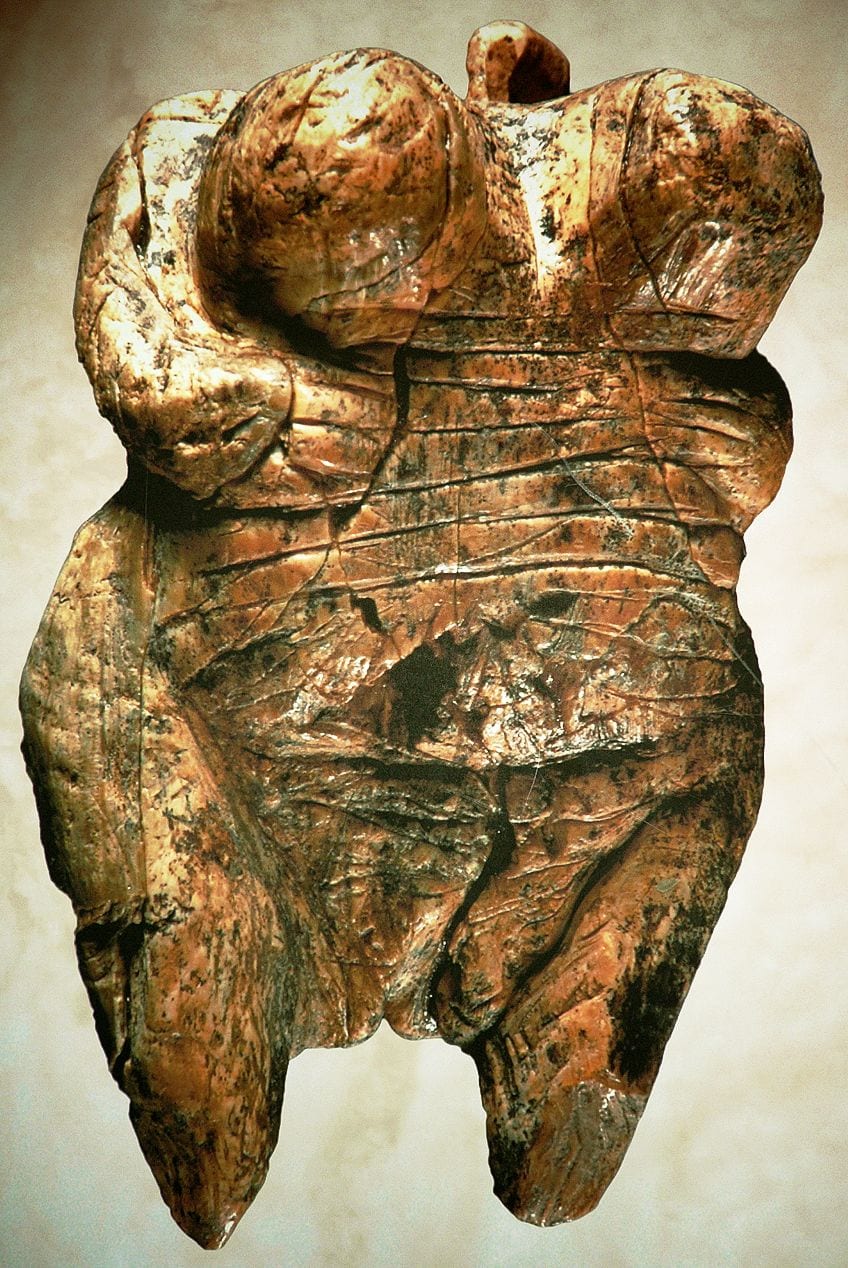
Example of Paleolithic Cave Paintings: Chauvet-Pont-d’Arc
When it comes to examples of Paleolithic cave paintings, the most well-known instance would most likely be The Chauvet-Pont-d’Arc. Chauvet–Pont d’Arc is a decorated cavern in southeast France that is regarded as one of the most important Paleolithic shelters ever uncovered. It is notable for the uniqueness and brilliance of its animal portrayals, as well as its antiquity.
People visited the cave twice, once around 36,000 years ago and again around 5,000 – 6,000 years later. The Aurignacians, the previous visitors, executed most of the artwork. They did not reside in the cave; instead, they utilized it for rites.
The few fires their predecessors, the Gravettians, built were not to cook food, but to create the charcoal they needed for their Paleolithic drawings. The first humans did not sketch on every accessible surface. For instance, the sides of the Chamber of the Bear Wallows, a massive expanse immediately after the entry, are completely free of pictures, most likely due to the natural daylight that reached them.
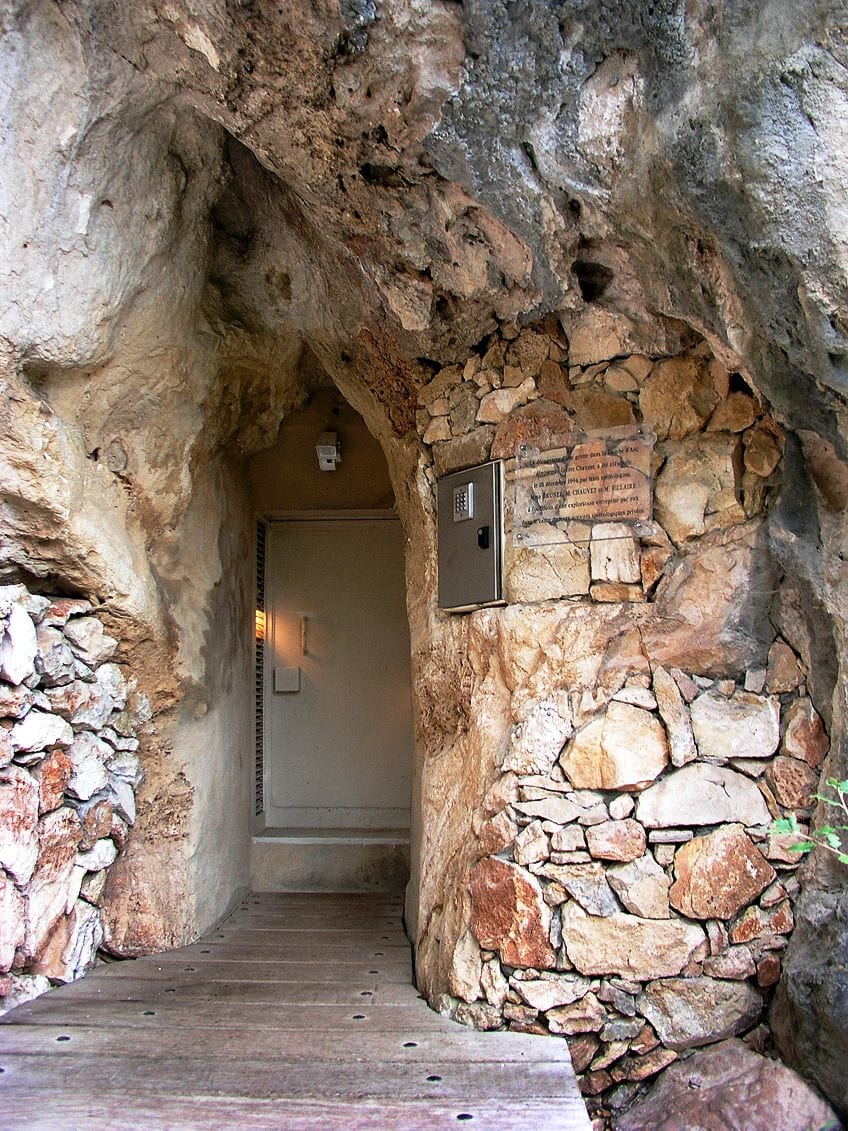
All photographs have to be created by torchlight in utter darkness. They sometimes picked the end of an obscure tiny corridor (for example, the Vestibule of Red Bears), while other times they gathered pictures on a large panel (e.g., Panel of the Lions, Panel of the Horses).
Other discoveries appear to be the result of purposeful selections as well. The majority of the drawings in the cave’s early chambers were created in red (a pigment produced from hematite, a naturally occurring iron oxide), with only a few designs in black. A transitional chamber has just two engravings and one small red mark at either end, whereas the second portion of the cave has predominantly charcoal or white engravings.
The rationale behind these selections is unknown to experts. As is customary in Paleolithic artworks, the majority of the paintings at Chauvet–Pont d’Arc depict animals, with only a few people and a few geometric “signs.” The range of animal species shown in the Chauvet–Pont d’Arc cave is unparalleled. Another noteworthy aspect of Chauvet–Pont d’Arc is that lions, mammoths, rhinos, and bears—the region’s most fearsome animals—constitute more than 60% of the figures, although bison and horses are more common in caves painted later in time.

The sole allusion to humanity is a frontal view of the bottom half of a woman’s body beside a bison with a person’s arm. There are also a half-dozen images of female anatomy and an equal number of hand stencils. Even though they look basic, the photos were sometimes used with remarkable subtlety and experience.
Some walls, for example, were scraped to offer a blank canvas on which to draw.
When the picture was made, its exterior outlines were slightly underlined to make it stand out, using a technique known as stump drawing (i.e., distributing the color with the hand to generate shade). At least one outstanding artist was working in the cave – possibly more.
Upper Paleolithic art is the most primitive kind of ancient art. Paleolithic cave paintings composed of hand stencils and simple geometric patterns stretch back at least 40,000 years. The advent of figurative paleolithic drawings has been seen as a sign of the beginning of social modernity in Paleolithic society, and it is one of the differentiating elements that separates the Upper Paleolithic period from the Middle Paleolithic period. The discovery of paleolithic murals in caves in Indonesia that are as old as the oldest European examples have demonstrated that similar artistic activities occurred 40,000 years ago in both western and eastern Eurasia.
Frequently Asked Questions
What Does Paleolithic Mean?
The term Paleolithic technically means Old Stone, but it refers to a period in our past when scavenging, foraging, and hunting were the predominant methods of acquiring sustenance. Humans had not yet experimented with domesticating animals or cultivating plants. Because hunter-gatherers could not depend on agricultural ways to generate food on purpose, their meals were reliant on natural ecosystem variations. They attempted to manage such processes in specific ways, such as rotating, hunting, and gathering, to guarantee enough food security for their people.
What is the Paleolithic Art Definition?
It refers to art created during the Paleolithic period. The Paleolithic Age, which spanned from roughly 30,000 BCE to 10,000 BCE, saw the earliest examples of human ingenuity. Due to the lack of written materials from this time period, practically all of our understanding of Paleolithic culture and ways of life is based on archeological and anthropological similarities to modern hunter-gatherer cultures. The Paleolithic period lasted until the ice melted, at which point farming and the usage of metals were introduced. It has been hypothesized that the earliest coastal migratory migration spread an artistic heritage that dates back more than 50,000 years all the way along Eurasia’s southern shore. At the conclusion of the Paleolithic epoch, people began to create artwork such as Paleolithic cave paintings and jewelry, as well as religious traditions like ritualistic burial practices.
Isabella studied at the University of Cape Town in South Africa and graduated with a Bachelor of Arts majoring in English Literature & Language and Psychology. Throughout her undergraduate years, she took Art History as an additional subject and absolutely loved it. Building on from her art history knowledge that began in high school, art has always been a particular area of fascination for her. From learning about artworks previously unknown to her, or sharpening her existing understanding of specific works, the ability to continue learning within this interesting sphere excites her greatly.
Her focal points of interest in art history encompass profiling specific artists and art movements, as it is these areas where she is able to really dig deep into the rich narrative of the art world. Additionally, she particularly enjoys exploring the different artistic styles of the 20th century, as well as the important impact that female artists have had on the development of art history.
Learn more about Isabella Meyer and the Art in Context Team.
Cite this Article
Isabella, Meyer, “Paleolithic Art – A Look at Paleolithic Culture and Its History.” Art in Context. March 15, 2022. URL: https://artincontext.org/paleolithic-art/
Meyer, I. (2022, 15 March). Paleolithic Art – A Look at Paleolithic Culture and Its History. Art in Context. https://artincontext.org/paleolithic-art/
Meyer, Isabella. “Paleolithic Art – A Look at Paleolithic Culture and Its History.” Art in Context, March 15, 2022. https://artincontext.org/paleolithic-art/.








